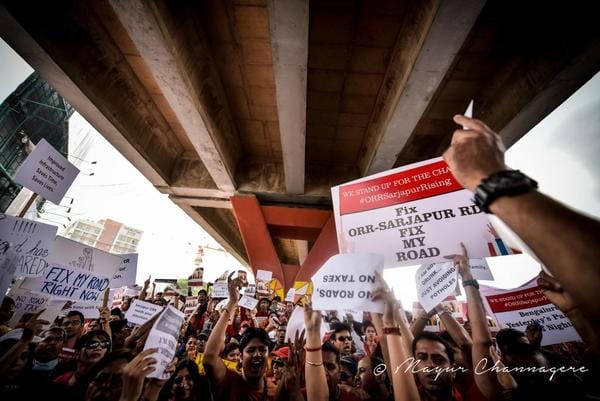
Pic: Mayur Channagere
Over 2,000 people formed a sea of red, under the Ibblur Flyover this Friday noon. They braved the sun, dust and traffic taking time off work and chores to protest against poor quality roads, daily jams, and smog filled air. Residents of Sarjapur Road and ORR neighbourhoods were upset that though Bellandur ward is one of the highest tax paying wards in Bengaluru, the state of civic infrastructure is extremely poor.
People were waving placards and shouting slogans demanding the government fix the problems. Roads have not been properly laid in years, and there are no footpaths – this affects the lakhs of residents including office goers, school children and workers that use the main arterial Sarjapur Road and ORR. Commuters and pedestrians struggle to navigate potholes and traffic and spend hours on the road everyday. Bellandur and nearby wards also suffer from lack of proper stormwater drains, water and sewerage lines.
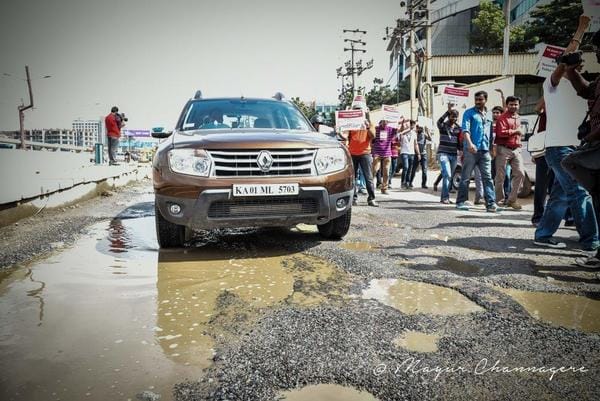
Pic: Mayur Channagere
Asked about what pushed the group into protesting, Shilpi Sahu, one of the initiators of the event, says, “In office, we are talking about traffic instead of work. When I go home, my husband cribs about traffic, my son spends two hours in traffic, my life is full of traffic.”
The organisers have been particular in maintaining a peaceful gathering and have reached out to a large diverse section of the residents, from workers, auto drivers, village residents, schools, corporates, apartments to gated communities.
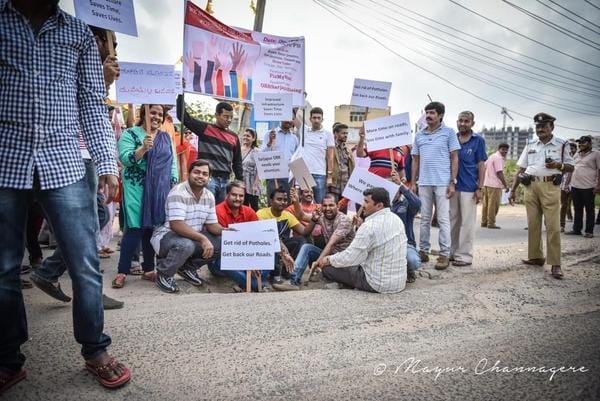
Pic: Mayur Channagere
Veerabadra, a driver who resides at Uttarahalli commutes to Bellandur where his employer lives. He says spends two hours in the morning and upto 4 hours in the evening on this commute to work and back home. He says, “Every signal – Ecospace, Ibblur, Agara, HSR, Silkboard – every signal is jammed.” He says, school kids don’t reach on time and even ambulances will see patients pass out, such is the plight of people on this road.
Dileep Kumar, a driver and resident of Devarabeesanhalli says he gets back pain holding the clutch constantly, and clutch pads wear out within months driving in clogged traffic. Munikrishna, 40, an auto driver, says it takes him almost an hour on Sarjapur Road, from Wipro to Ibblur to earn the minimum meter charge of Rs. 25.
Sameer Shisodia, a resident of the neighbourhood, who usually cycles to work, insists public transportation is the only option. Given that a rail network already exists in a large part of the city, and is cheap, quick and can be made operational quickly, the focus needs to be on rolling it out immediately, with feeder buses. He explains, “Carmelram train station is just a few minutes away from our area, frequent commuter train services to Whitefield side can reduce the pressure on ORR to a great extent.”

Pic: Mayur Channagere
Shalini Susheel, another resident bemoans the lack of alternate routes to split the traffic. She says the CDP 2015 had identified additional roads, which have not been developed. Bhagath Reddy, who also resides off ORR, says “To get out of my home and onto the main road takes 45 minutes! My children, aged 4 and 8, take 2 hours to reach home from school, instead of the earlier 45 minutes.”
Shabana who works as a nanny in a villa community on ORR, complains about the difficulty of getting to her workplace from her home on the other side of the road. She says, “it is impossible to cross the road,I have to walk up to Bellandur junction to cross the road, plus the footpaths are unusable.” Her daughter Najma who works at Ecospace housekeeping says it is very scary at nights when she is on the evening shift, as the footpaths have gaps that one can fall into. The pollution has affected everyone in their family, with the children falling ill often with respiratory infections.
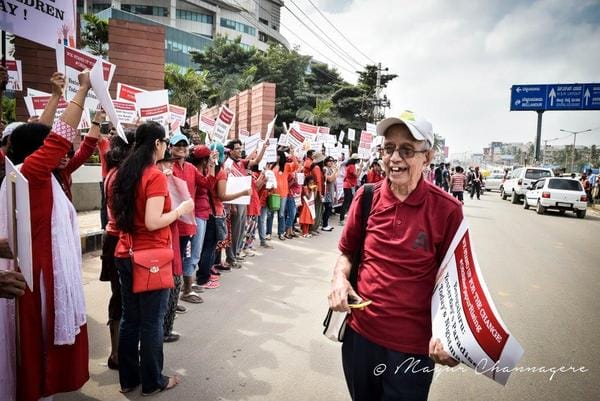
Pic: Mayur Channagere
A senior person who handles real estate deals on ORR says that IT Majors are already looking at Hyderabad because of the better infrastructure there. Before they take the decision to move out, Bangalore authorities need to wake up and act immediately. He says, “You can forget about any new commercial development because existing commercial properties are already at the point of losing out on renewal of leases.“
Meera Nair, a resident of Sarjapur Road observes that there is a lot of mindless development — from residential apartments to SEZ, that has worsened the situation. Without proper infrastructure and planning in place, the development formula is going to backfire into the real estate developers’ faces and devalue their properties.
A petition on Change.org has gathered over 7000 signatures in a week.
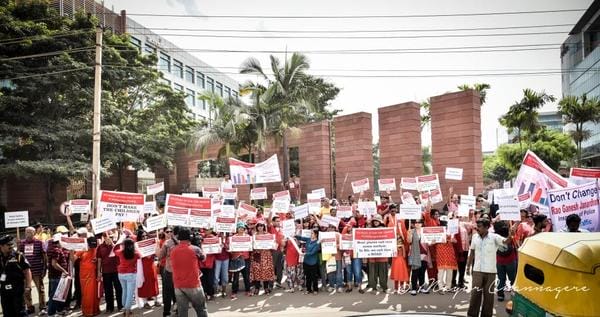
Pic: Mayur Channagere
The protesters demanded:
Immediate:
- Fix potholes and lay new roads on ORR, Sarjapur Road and all internal roads in Sarjapur ORR areas
- Proper footpaths and drainages
- Scientific planning of Junctions, U-turns, Bus Bays and Bus Stops, earmark zones for vendors/kiosks.
- Removal of all encroachments from major roads and service road of ORR
- Constitute a committee (citizens, corporates & government agencies) to improve ORR – Sarjapur Road corridor.
Long-term:
- Plan for mass transit in this corridor – Commuter Rail, BRTS, Metro
- Release the DPR (Detailed Project Report) for Sarjapur road widening and collaborate with the above committee with detailed timelines. (Plan approved in Karnataka Govt. Budget)
- Identify alternate routes, widen narrow routes to reduce load on arterial roads and implement new roads as per CDP 2015.
- Exclusive cycle lanes and skywalks
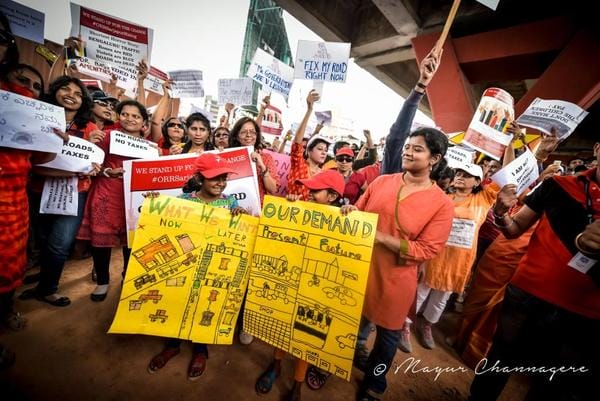
Pic: Mayur Channagere
BBMP Joint Commissioner, Mahadevapura zone, Umanand Rai addressed citizens, informing them that KJ George, Minister for Bangalore Development has said he will meet citizens to discuss their issues within a week. Transport minister Ramalinga Reddy also sent a message promising to organise a meeting with BMTC and traffic police to find solutions for the traffic issues.
Local MLA Arvind Limbavali had also sent out a message supporting the protest, which he said will help him further increase the pressure on the government to provide more grants for more grants for basic infrastructure.
Citizens plan to follow up on their promises and engage with elected representatives and officials in solving this huge issue that affects everybody.
Related Articles
Mugging incidents on Outer Ring Road
‘Strictly no right turn at the Intel junction on Outer Ring Road please!’
ORR at Bellandur: Signal free corridor adds to commuters’ stress
Traffic on ORR is likely to worsen. Here’s why!
Fix ORR-Sarjapur Road – Fed up citizens protest
ORR flyover work by BDA chokes traffic
Very well captured Meera
Our politicians were trained in -fill in the blanks- .
Here is a story that could easily be Namma Bengaluru:
Protests are not the only sign of growing unease. Concerned citizens have been circulating leaflets warnings of the health dangers, and using WhatsApp to warn people not to eat in restaurants and to avoid eating fresh vegetables.
“_________ is an unhealthy place, even before the garbage issue,” “Now, it’s even more of a disaster.”
Better read this :
https://www.washingtonpost.com/blogs/monkey-cage/wp/2015/09/18/this-isnt-lebanons-first-garbage-crisis-and-what-that-should-teach-us/
A briefing issued by the World Health Organization in September warned of a wide range of possible health impacts, from respiratory problems, headaches and cancers in the case of long term exposure. Of “major concern,” it adds, is water pollution.
______ has attended protests with a placard emblazoned with a warning borrowed from the TV
“If it’s not cholera, it’s the food, it’s the air. These diseases would affect everyone.” he said.
And with the movement attracting dwindling numbers, he fears the pressure is easing off government to deal with the crisis.
Informed about the creation of a taskforce to advise on the government on health risks, he scoffed.
“They’re still burning mountains of trash every day, and all we can do is close the windows,” he said. “I’ll believe it when I see results. I just hope when it starts raining again people will wake up to the threat.”